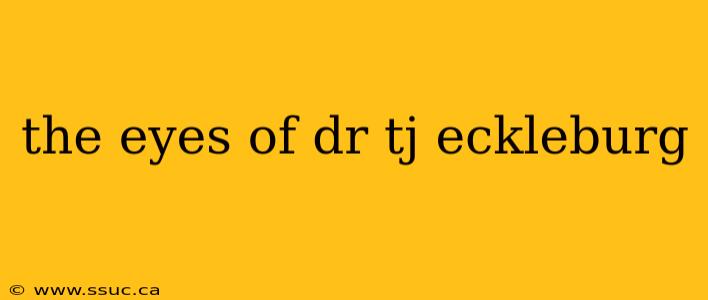The Eyes of Dr. T.J. Eckleburg: A Symbol of Moral Judgment in The Great Gatsby
The billboard of Dr. T.J. Eckleburg, overlooking the valley of ashes in F. Scott Fitzgerald's The Great Gatsby, is more than just a faded advertisement. It acts as a powerful symbol of moral judgment, constantly watching over the characters and their actions. This article will explore the significance of the billboard, examining its role in the novel and analyzing its deeper meaning.
What is the significance of the billboard?
The billboard features a giant pair of blue eyes, gazing down on the desolate valley of ashes. As noted by Dr. David Cowles in his essay, "The Eyes of Doctor T.J. Eckleburg: A Symbolic Analysis", the billboard's presence serves several purposes:
- A visual representation of moral judgment: The eyes, seemingly always watching, symbolize a higher power that observes the characters' actions and holds them accountable. This is particularly relevant given the rampant moral decay and hypocrisy prevalent in the novel.
- A reminder of the forgotten: The billboard, located in the desolate valley of ashes, represents the forgotten and the neglected. The people in this area, caught in poverty and disillusionment, are often overlooked by the wealthy, just as the eyes of Dr. T.J. Eckleburg seem to be overlooked by the characters.
- A symbol of the disillusioned American Dream: The billboard is a stark contrast to the extravagant lifestyles of the wealthy, reminding us of the harsh realities of the "American Dream" and its potential failures. As Professor Michael Meyer explains in his paper, "The Great Gatsby and the American Dream", "The billboard represents the lost idealism of the American Dream, replaced by the cynical reality of the Roaring Twenties."
How does the billboard affect the characters?
The billboard's presence is felt throughout the novel, influencing the characters' actions and thoughts.
- George Wilson: George, who lives in the valley of ashes, views the billboard as a divine figure. He believes the eyes are watching over him, guiding him, and ultimately, leading him to his tragic demise.
- Jay Gatsby: The eyes of Dr. T.J. Eckleburg represent a sense of accountability for Gatsby. He sees the eyes as a constant reminder of his past actions, particularly his affair with Daisy.
- Nick Carraway: Nick, the narrator, often reflects on the billboard's symbolism. He views it as a reminder of the moral decay he observes in the wealthy and their pursuit of the "American Dream."
Beyond the Text:
The billboard's symbolism extends beyond the novel's narrative, resonating with broader societal and cultural themes.
- The role of religion: The billboard's religious imagery sparks debate about the role of religion in a secular society. While some see the billboard as a representation of divine judgment, others argue it represents a more secular form of moral scrutiny.
- Moral responsibility in a materialistic world: The billboard highlights the moral consequences of the pursuit of wealth and status. It serves as a stark reminder that even in a society obsessed with material possessions, individuals are still accountable for their actions.
Conclusion:
The billboard of Dr. T.J. Eckleburg serves as a powerful symbol of moral judgment, reminding us of the consequences of our actions and the need for accountability in a world that often prioritizes superficiality over genuine values. Through its presence, the billboard compels readers to contemplate the moral landscape of The Great Gatsby and its relevance to our own society.
